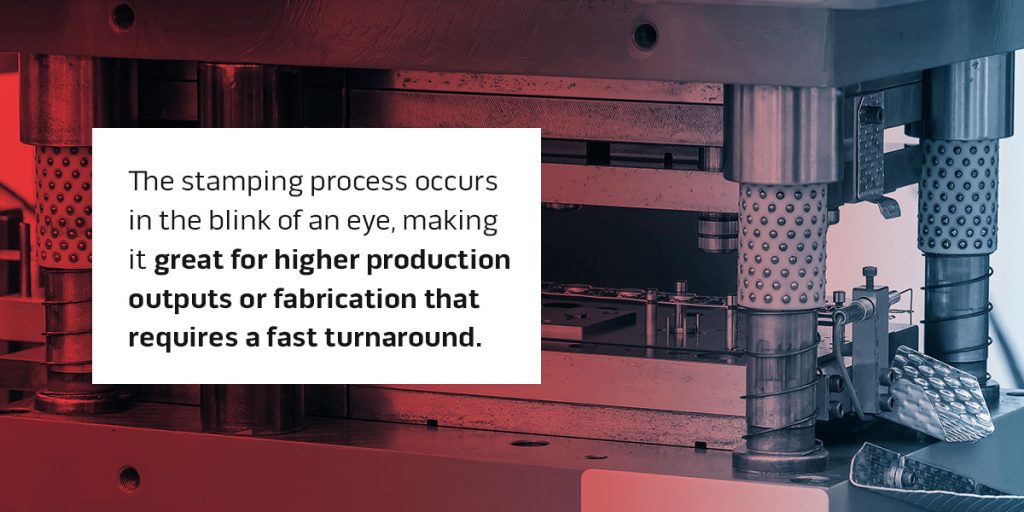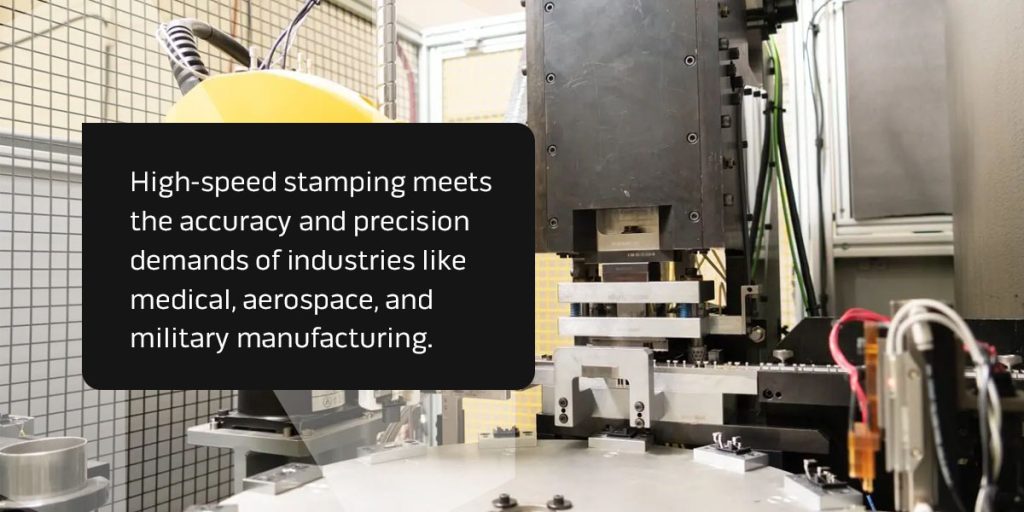
In manufacturing, time is critical, and high-speed stamping processes allow for faster, more profitable production for a wide range of parts. This fabrication method supports all kinds of industries with precision and versatility. High-speed stamping can create the parts for everything from consumer electronics to aerospace equipment, and it works well with various materials.
If you need to create a high number of parts quickly or economically, high-speed stamping could be the perfect fit.
Typical stamping processes use a press to sandwich a piece of material between a press and a die. The die has a shape cut into it that punches, cuts or shapes the material. This method is often used with metal, but materials like plastics and rubber can also be stamped.
High-speed stamping increases the speed of the operation, but the amount can vary by industry. For example, a large die might have fewer than 100 strokes per minute, while a smaller one could support over 1,000.
The common denominator of high-speed presses is that they require special accommodations to address the unique demands of faster operating speeds. Some of the primary concerns associated with high-speed stamping include:
Overcoming these issues yields some powerful results, offering low-cost, accurate and fast production. The high-speed capabilities of this method have made it a necessary technology for many companies and industries. Some markets that depend on high-speed stamping include the automotive, aerospace, medical and consumer electronics industries.
The main types of high-speed stamping are hydraulic and mechanical stamping. The one you choose will depend on the application and material.
In this type of high-speed stamping, a motor-driven flywheel powers a mechanical stamping press. The flywheel stores and transfers energy to a crankshaft, which moves the press ram in a fast, repetitive motion. This setup allows for high-speed, high-force stamping with consistent strokes.
Mechanical presses operate at fixed stroke lengths and speeds, making them best suited for applications requiring fast, repeatable production, such as high-volume manufacturing of precision parts like electrical connectors and automotive components.
A hydraulic high-speed stamping press uses pressurized fluid to generate force. A hydraulic system pumps fluid into cylinders, creating controlled pressure that moves the press ram. This control allows for smooth, consistent force throughout the stroke, making it easy to adjust pressure and speed.
Unlike mechanical presses, hydraulic presses can pause mid-stroke or apply full force at any point, offering greater flexibility for complex shaping, deep drawing and stamping thick or delicate materials.
High-speed stamping is essential in manufacturing industries, and it requires precision, efficiency, and scalability. Some of these sectors include:
High-speed stamping relies on several crucial pieces of equipment, although this manufacturing process can vary slightly. In general, high-speed stamping follows these steps:

The stamping process occurs in the blink of an eye, making it great for higher production outputs or fabrication that requires a fast turnaround.
High-speed stamping shapes various metals into precise components. Common materials include stainless steel for its strength and resistance, aluminum for its lightweight nature, copper for its excellent conductivity and brass for its durability in precision applications.
High-speed stamping also enables the production of high-strength alloy products for demanding environments like aerospace and automotive safety components.
High-speed stamping is ideal for many fabrication applications, especially where simple, consistent shapes are required. Below are some of the reasons so many companies turn to this fabrication method for their parts.
High-speed stamping offers quick turnaround times and impressive throughputs that can accommodate some of the fastest production runs. If your operation requires a large number of parts in very little time, high-speed stamping could be the perfect approach. It can help you get to market sooner and gain a competitive edge over other businesses in your industry.
Although it requires specialized equipment and training, the speed of this method often makes it an economical choice, especially when outsourced. Its high-quality results and automated system minimize labor requirements and material waste. Getting products out faster than the competition can also boost your bottom line.

Many industries, like medical, aerospace and military manufacturers, demand accuracy and precision. High-speed stamping can meet both of these requirements. It’s also highly repeatable and great for products with low tolerances or variation allowances.
Stamping presses can accommodate different types of metals and thicknesses, from stainless steel to copper and brass. While each one requires some adjustments to the equipment, a skilled fabricator can bring the benefits of high-speed stamping to various metals.
Although high-speed stamping is crucial for many businesses, it requires considerable skill. This type of fabrication introduces unique stressors, such as those related to equipment wear, stock feeding and scrap removal.
Any company using a high-speed press must implement specialized training for technicians, follow intense maintenance requirements and invest in the right equipment. Doing this in-house can be expensive and challenging, but an outsourced solution offers all of the benefits at an affordable price.
Unlike suppliers who outsource tooling or post-processing, New Concept Technology handles everything in-house—from tool design to final part inspection. That means faster lead times, tighter tolerances, and complete process control.
Working with New Concept Technology allows you to leverage our expert team and industry-leading equipment without taking on the drawbacks. Our comprehensive manufacturing services ensure that you get the best quality and efficiency in production. Additionally, our rapid design and prototyping capabilities enable us to develop and refine your concepts quickly, ensuring a seamless transition from idea to production along with these other benefits:
As your single-source supplier, we offer design, engineering, process development, fabrication and manufacturing all in one place. Our manufacturing process integration helps us improve efficiency and incorporate custom designs into your product while maintaining quality and speed.
Using a high-speed stamping press is an essential kind of production for numerous types of businesses. If you need fast, precise fabrication for high production outputs, consider working with the experts in high-speed stamping. New Concept Technology brings leading technology and expertise to the process and serves as your one-stop shop.
Contact us today to learn more about our high-speed stamping capabilities and take your production to the next step.